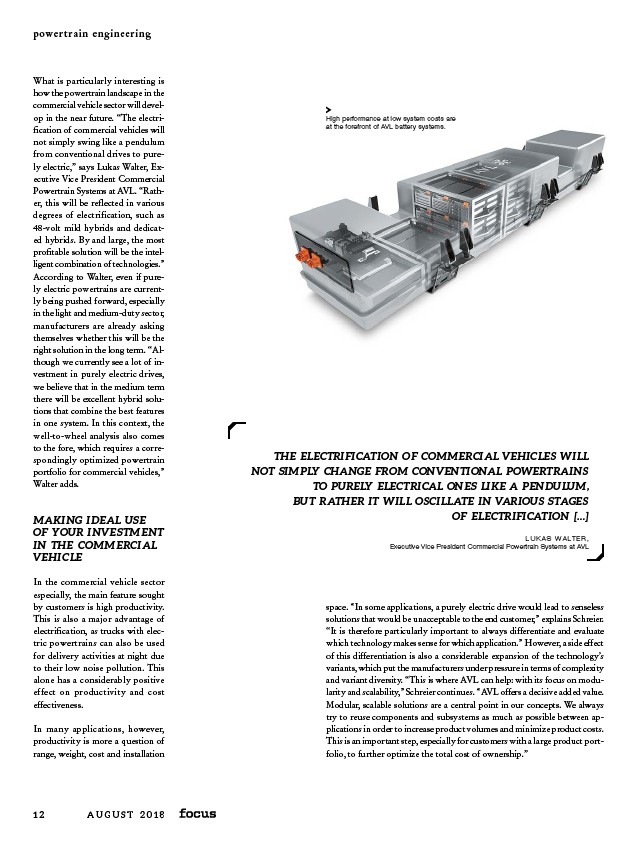
powertrain engineering
1 2 A U G U S T 2 0 1 8
High performance at low system costs are
at the forefront of AVL battery systems.
THE ELECTRIFICATION OF COMMERCIAL VEHICLES WILL
NOT SIMPLY CHANGE FROM CONVENTIONAL POWERTRAINS
TO PURELY ELECTRICAL ONES LIKE A PENDULUM,
BUT RATHER IT WILL OSCILLATE IN VARIOUS STAGES
OF ELECTRIFICATION …
LUKAS WALTER,
Executive Vice President Commercial Powertrain Systems at AVL
What is particularly interesting is
how the powertrain landscape in the
commercial vehicle sector will develop
in the near future. “The electrification
of commercial vehicles will
not simply swing like a pendulum
from conventional drives to purely
electric,” says Lukas Walter, Executive
Vice President Commercial
Powertrain Systems at AVL. “Rather,
this will be reflected in various
degrees of electrification, such as
48-volt mild hybrids and dedicated
hybrids. By and large, the most
profitable solution will be the intelligent
combination of technologies.”
According to Walter, even if purely
electric powertrains are currently
being pushed forward, especially
in the light and medium-duty sector,
manufacturers are already asking
themselves whether this will be the
right solution in the long term. “Although
we currently see a lot of investment
in purely electric drives,
we believe that in the medium term
there will be excellent hybrid solutions
that combine the best features
in one system. In this context, the
well-to-wheel analysis also comes
to the fore, which requires a correspondingly
optimized powertrain
portfolio for commercial vehicles,”
Walter adds.
MAKING IDEAL USE
OF YOUR INVESTMENT
IN THE COMMERCIAL
VEHICLE
In the commercial vehicle sector
especially, the main feature sought
by customers is high productivity.
This is also a major advantage of
electrification, as trucks with electric
powertrains can also be used
for delivery activities at night due
to their low noise pollution. This
alone has a considerably positive
effect on productivity and cost
effectiveness.
In many applications, however,
productivity is more a question of
range, weight, cost and installation
space. “In some applications, a purely electric drive would lead to senseless
solutions that would be unacceptable to the end customer,” explains Schreier.
“It is therefore particularly important to always differentiate and evaluate
which technology makes sense for which application.” However, a side effect
of this differentiation is also a considerable expansion of the technology’s
variants, which put the manufacturers under pressure in terms of complexity
and variant diversity. “This is where AVL can help: with its focus on modularity
and scalability,” Schreier continues. “AVL offers a decisive added value.
Modular, scalable solutions are a central point in our concepts. We always
try to reuse components and subsystems as much as possible between applications
in order to increase product volumes and minimize product costs.
This is an important step, especially for customers with a large product portfolio,
to further optimize the total cost of ownership.”